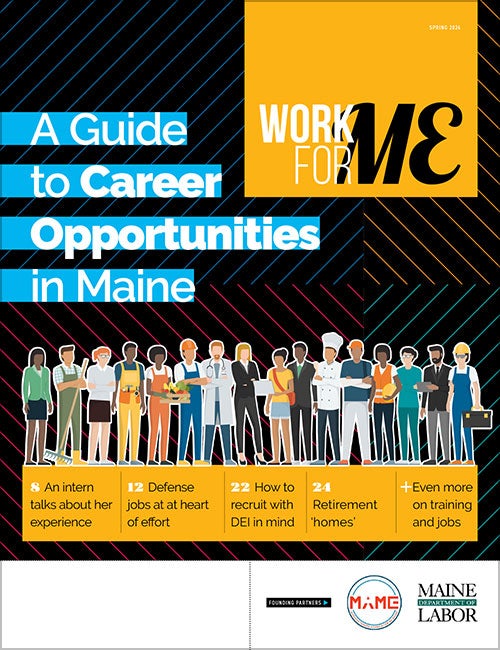
Processing Your Payment
Please do not leave this page until complete. This can take a few moments.
- News
-
Editions
-
- Lists
-
Viewpoints
-
Our Events
-
Event Info
- Business Leaders of the Year Reception 2025
- Women's Leadership Forum 2025
- On the Road with Mainebiz in Bethel
- Health Care Forum 2025
- On The Road with Mainebiz in Greenville
- On The Road with Mainebiz in Waterville
- Small Business Forum 2025
- Outstanding Women in Business Reception 2025
- On The Road with Mainebiz in Bath
- 60 Ideas in 60 Minutes Portland 2025
- 40 Under 40 Awards Reception 2025
- On The Road with Mainebiz in Lewiston / Auburn
- 60 Ideas in 60 Minutes Bangor 2025
Award Honorees
- 2025 Business Leaders of the Year
- 2024 Women to Watch Honorees
- 2024 Business Leaders of the Year
- 2023 NextUp: 40 Under 40 Honorees
- 2023 Women to Watch Honorees
- 2023 Business Leaders of the Year
- 2022 NextUp: 40 Under 40 Honorees
- 2022 Women to Watch Honorees
- 2022 Business Leaders of the Year
-
-
Calendar
-
Biz Marketplace
- News
- Editions
- Lists
- Viewpoints
-
Our Events
Event Info
- View all Events
- Business Leaders of the Year Reception 2025
- Women's Leadership Forum 2025
- On the Road with Mainebiz in Bethel
- Health Care Forum 2025
- On The Road with Mainebiz in Greenville
- + More
- On The Road with Mainebiz in Waterville
- Small Business Forum 2025
- Outstanding Women in Business Reception 2025
- On The Road with Mainebiz in Bath
- 60 Ideas in 60 Minutes Portland 2025
- 40 Under 40 Awards Reception 2025
- On The Road with Mainebiz in Lewiston / Auburn
- 60 Ideas in 60 Minutes Bangor 2025
- - Less
Award Honorees
- 2025 Business Leaders of the Year
- 2024 Women to Watch Honorees
- 2024 Business Leaders of the Year
- 2023 NextUp: 40 Under 40 Honorees
- 2023 Women to Watch Honorees
- 2023 Business Leaders of the Year
- + More
- 2022 NextUp: 40 Under 40 Honorees
- 2022 Women to Watch Honorees
- 2022 Business Leaders of the Year
- Nomination Forms
- Calendar
- Biz Marketplace
How to hire for 'fit' rather than just hiring for skills
For years, companies have leaned on the traditional approach of hiring for skills and experience, assuming this strategy would quickly address their workforce needs.

But this mindset often overlooks a critical factor: fit. In today’s competitive talent market, hiring for fit — prioritizing cultural and role alignment, attitude, and potential — is not just a trend. It’s a necessity.
Why skills alone aren’t enough
Skills and experience are important, but they’re not the full picture. Employees who align with an organization’s culture are more likely to stay and thrive. High turnover rates and disengaged teams often stem from cultural mismatches, not skill gaps. I recently learned about a large manufacturer in Maine that exemplifies this challenge. Facing a high turnover rate, the company plans to hire hundreds of employees in 2025, with a goal of retaining just 20% to 30%. This approach is extremely costly and unsustainable.
The rapid pace of technological advancement also renders many skills obsolete within a few years. Adaptability and a willingness to learn are valuable traits that cannot be captured in a resume. Businesses that hire for fit can build resilient teams capable of evolving alongside industry changes.
The benefits of hiring for fit
Engage and retain. Employees who feel connected to their workplace culture are more likely to stay. This connection fosters loyalty, reducing turnover costs and building a stable workforce. Replacing an employee can cost up to six months of their salary, making retention critical.
Fulfillment in the role. Employees perform best when their roles align with their interests, strengths, and career goals. A good fit ensures that candidates are placed in jobs where they feel challenged and fulfilled, driving higher engagement and productivity.
Provide trainable skills. Technical skills can be taught, but qualities like curiosity, empathy and collaboration are inherent. Hiring for fit cultivates long-term contributors who can grow within the organization.
Build stronger teams. When employees align with an organization’s values and mission, collaboration improves. Teams that share a common purpose are more productive and innovative.
How to shift to hiring for fit
Rethink job descriptions. Focus on traits and values that reflect company culture. Highlight adaptability, problem-solving, and teamwork alongside technical requirements.
Revamp interview processes. Use behavioral and situational questions to assess cultural alignment. For example, ask, “Describe a workplace situation where you felt truly engaged and motivated. What factors contributed to that experience?
Use assessment tools. Personality and values assessments reveal alignment beyond what’s visible in a resume, providing deeper insights into candidate fit.
Invest in onboarding and training. Structured onboarding and ongoing training ensure new hires develop necessary skills while reinforcing cultural alignment. Success stories of employees excelling after training can inspire confidence in this approach.
The business case for hiring for fit
Smart strategy. Hiring for fit isn’t just good for employees; it’s a smart business strategy. Open vacancies are costly. For instance, a Maine auto dealer shared with me that a single unfilled position in its shop can result in up to $30,000 in lost revenue per month.
Turnover costs are equally significant. Beyond the financial burden, constant churn disrupts operations, reduces productivity, and strains staff. Prioritizing fit creates a stable, engaged workforce that drives long-term success.
Organizations with strong cultural alignment often enjoy better reputations. People want to work for companies that treat their employees well and foster positive environments. This reputation attracts talent and resonates with customers who value ethical business practices.
Recruiting for the long-term
The challenges of today’s labor market demand a shift in perspective. Hiring for skills and experience alone is no longer sufficient. By prioritizing fit, companies can build resilient, engaged teams that drive sustainable growth.
The process may require rethinking traditional hiring practices, but the long-term benefits — from reduced turnover to stronger teams — far outweigh the initial investment.
It’s time to stop viewing recruitment as a short-term fix and start seeing it as a strategic opportunity to shape the future of your organization.
About the author
John Lewis is co-founder and managing partner at Synergy Workforce Solutions LLC. He is also the co-chair of the Manufacturers Association of Maine’s committee on employee growth services. John can be reached at john@synworkforce.com










0 Comments